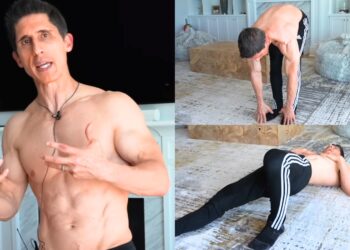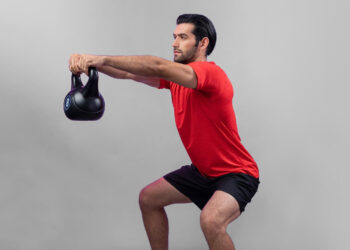This calculator gives an estimate of how many calories are burned while stretching. The average person will burn 165-220 calories per hour stretching with mild intensity.
How to Use The Calculator
To calculate the calories burned stretching you must simply plugin 2 values, then search for the activity you have done, and the intensity of the activity. You will find the calories burned doing the activity from there. This is how you do that.
- Choose the unit of measurement – kilograms or pounds
- Enter your weight and the time spent stretching
- Look for the specific stretching activity you have done and enter time you put into it
- Hit Calculate
Once you hit calculate you should see the number of calories you burned stretching.
How The Calculator Works
MET
MET is a value that represents the ratio between your resting metabolic rate (RMR), which is also called your basal metabolic rate (BMR), relative to your active metabolic rate (AMR).
Your RMR is the energy your body uses at rest, and when it is not actively digesting. This is also the same thing as your BMR.
Your active metabolic rate is the energy your body uses along with your resting metabolic rate.
Level Up Your Fitness: Join our 💪 strong community in Fitness Volt Newsletter. Get daily inspiration, expert-backed workouts, nutrition tips, the latest in strength sports, and the support you need to reach your goals. Subscribe for free!
This calculator uses MET values to calculate the calories burned doing various tasks. A MET value is given to physical activities to rate the energy expenditure of the activities.
The higher the MET, the more calories are burned doing that activity. An activity with a MET of 1 is equal to your RMR, while a task with a MET of 5 burns 5 times more calories than an activity with a MET of 1.
Along with MET values being used in the equation, 3.5 ml is also used in the equation. Your muscles use 3.5 ml of oxygen per minute per kilogram of body weight.
You can calculate the amount of oxygen your muscles use per minute by multiplying your body weight in kilograms by 3.5.
Formula
Total Calories burned in 1 minute = (3.5 x MET x body weight in kg)/200
Examples
A person weighing 150 pounds will burn 150 to 200 calories per hour stretching.
- Calories burned (per minute) = (body weight in kg x MET x 3.5) / 200
The formula to calculate the calories burned per minute for a 150-pound person is done like this.
- (68.0389 kg x 2.3 x 3.5) / 200 = 2.7386 calories burned per minute of stretching
To calculate the number of calories burned per hour stretching, you multiply the calories burned per minute by 60 (minutes)
- Calories per hour burned = 2.7386 x 60
164 calories will be burned per hour stretching.
Results
A 150 pounds person will burn 164 calories per hour stretching using the MET formula. A 150-pound person will also burn 2.27386 calories per minute stretching.
What is Stretching?
Stretching is a form of exercise that consists of stretching and flexing a muscle or tendon specifically to improve its elasticity (how far the muscle or tendon can move in its range of motion). Stretching helps to gain muscle control and flexibility in the muscle or tendon that improves range of motion.
Stretching is also an instinctive action done by humans and animals alike. It happens instinctively after waking up from sleep, after long durations of inactivity, or after exiting small areas and spaces.
How is Stretching Done?
Stretching is usually done before a workout or exercise to warm up the muscles. Stretching is actually best done after the body is warmed up and after a workout, because stretching the muscles cold can increase the chance of injury and can make it harder to use muscles to their full capacity.
Stretching the muscles before a hypertrophy workout can decrease their capacity to grow muscle during that workout.
So, it is recommended that you stretch after a workout because your muscles will be warmed up and prepared to be stretched, giving lactic acid relief and a cooldown all in one, along with the given benefits of stretching that I listed above.
Lactic acid is the chemical that builds up in your bloodstream following intense exercise. It gives what is called the burning sensation in your muscles when you do intense exercise to failure.
Lactic acid is released when you stretch after a workout and stretching aids in the recovery process post-workout.
Stretching should be done daily to get the full benefits. Tightness in the muscles is accumulated over months, and even years, so stretching only a few times will not undo or help with that tightness. A short stretching routine done daily will help more than a long stretching routine once or twice a week.
Stretching can be done anytime, on any day, but it is always advised to warm up and go slow as to not injure yourself and do the stretches correctly.
Breathing and stretching go hand in hand, just like in many practices like Yoga, Taichi, Pilates, and other mind-body exercises such as those. Yoga consists of static and dynamic stretching along with breath control that together simulates meditation in motion.
Stretching exercises like yoga can help in giving the benefits of stretching, and the benefits of meditation all in one.
Related: Loosen Up! Five-Minute Mobility Workout for Lifters
The Different Types of Stretching
Dynamic and static stretching is the different types of stretching that are used in different instances.
Static Stretching
Static stretching is the stretching that everyone knows about, it is when you get into a stretched position then hold it for 30 seconds to a minute.
Level Up Your Fitness: Join our 💪 strong community in Fitness Volt Newsletter. Get daily inspiration, expert-backed workouts, nutrition tips, the latest in strength sports, and the support you need to reach your goals. Subscribe for free!
This type of stretching is best done after a workout, or in the morning after warming up.
Static stretching should be used sparingly or not at all before a workout because stretching the muscles cold can increase the risk of injury and put the muscles in a position for less growth.
Dynamic Stretching
Dynamic stretching is a type of stretching in motion. So, you will continuously move in and out of a stretched position using momentum.
Dynamic stretches are best used before a workout, or before doing any physical activity. Dynamic stretching helps with warming up the muscles and can be done cold, or before warming up because it can be a warmup itself.
It is safer starting off with dynamic stretching because it uses movement along with stretching the muscles and the tendons to warm up the muscles while stretching them.
Dynamic stretching is done by athletes before they perform, and static stretching is done slowly after performing, for better recovery and longevity.
Yoga
Yoga is a holistic method of mind-body exercise that involves both static stretches and dynamic stretches for what is called “meditation in motion”.
Meditation in motion is also attributed to Taichi, but Yoga is a practice originating in ancient India, with the purpose of teaching yourself how to control your mind and to be more mindful.
Yoga exercises are used by many athletes and people across the world for recovery from workouts, as a stress reliever, and as an aid to ease joint pain and back pain.
Yoga is recognized widely as a form of complementary and alternative therapy for a wide range of health problems, because of its usefulness.
Anyone can do Yoga with all the free tutorials and information on the web, it is safe for anyone to do, but it is recommended you consult with your doctor before you try any new workout routine or supplement.
Is Stretching a Good Activity for Weight Loss?
Stretching is an activity done before or after a workout. The only time stretching is used in the workout is if you are doing something like yoga or Pilates.
Stretching burns calories unlike cardio and other physical activities, so it is not a good activity for weight loss if done alone, but it is great for recovery from workouts that will burn a lot of calories.
Exercises like running, weight lifting, martial arts, or any sport would be perfect to utilize a stretch routine to help relieve tension in muscles and help with recovery from intense workouts.
You can’t make stretching a high-calorie burning exercise. Even choosing something like yoga will not make that much of a difference, since stretching is not meant to be intense as a workout.
If weight loss is your goal, try something like jumping rope, swimming, or some other low-impact cardiovascular exercise that will help you burn calories and lose weight.
Is stretching okay if you are overweight?
Definitely! Stretching is great for everyone because everyone can use some form of release from the tension and tightness we put onto our muscles in the modern-day.
Stretching exercises are great at reducing the stress level of an individual with lots of stress and even mental health issues. It is proven that exercise in general, even at a low intensity, is one of the greatest impactors of mental health in a positive way.
Stress is one of the factors that lead to weight gain and sustains it. So if you want to reduce stress and aid in your weight loss, stretching can help you lose weight and burn calories if done with mindful breathing and slowly.
Stretching does not put any impact on the joints, and it creates no risk for injury if done correctly and slowly. Easing your way into stretches and holding them for short periods of time will prove the best way to go if you have a low range of motion.
As long as you take your time and breath through movements, even without the range of motion, you will continue to improve and get better at stretching as long as you stay consistent.
FAQs
Does stretching burn calories?
Yes, with stretching you burn calories. For a 180-pound (82-kg) person, the average calories burned by stretching is a mere 165-220 calories per hour.
How many calories do you burn in 10 minutes of stretching?
For the average person, 10 minutes of stretching will burn 15-30 calories depending on the intensity.
How many calories do you burn in 30 minutes of stretching?
For the average person, 30 minutes of stretching will burn 82-130 calories.
Conclusion
Stretching is a form of exercise that consists of stretching and flexing a muscle or tendon specifically to improve its elasticity. Stretching can burn 165-220 calories for the average person mild stretching each hour.
Stretches should be done before and after exercising to improve the quality of exercise and even burn some extra calories. This is important for higher intensity activities like weight lifting since movement like stretching can lessen the time recovering from that workout.
The number of calories burned that you get from this calculator is an estimate, and doesn’t take into account sex, muscle mass, age, or individual factors outside of weight. This calculator gives an estimation that does not regard those variables.
References:
- What is stretching: https://en.wikipedia.org/wiki/Stretching
- The importance of stretching: https://www.health.harvard.edu/staying-healthy/the-importance-of-stretching
- What is yoga: https://en.wikipedia.org/wiki/Yoga
Additional References:
- Compendium of physical activities: Arizona State University
- WHO global recommendations on physical activity for health (updated): https://www.who.int




















